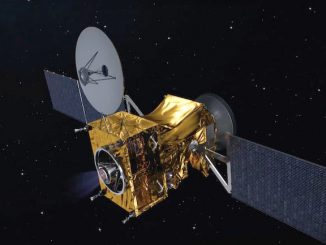
Following a series of tests conducted in space over the past five months, the ESA-JAXA BepiColombo mission has successfully completed its near-Earth commissioning phase and is now ready for the operations that will take place during the cruise and, eventually, for its scientific investigations at Mercury.
BepiColombo started its seven-year long journey to the solar system’s innermost planet on 20 October 2018, lifting off on an Ariane 5 rocket from Europe’s spaceport in Kourou, French Guiana.
After completing the launch and early orbit phase on 22 October, an extensive series of in-orbit commissioning activities started. During this near-Earth commissioning phase, which was concluded on 16 December, the European and Japanese mission teams performed tests to ensure the health of BepiColombo’s science instruments, its propulsion and other spacecraft platform systems.
On 26 March 2019, a review board confirmed that the overall capabilities and performance at the end of the near-Earth commissioning phase meet the mission requirements.
“We are very pleased with the performance of BepiColombo and proud of the work of all teams who made such a challenging mission a reality,” says Ulrich Reininghaus, ESA BepiColombo project manager.
This marks the end of the commissioning activities, and the operations team can focus on routine operations and on preparations for the mission’s first planetary gravity assist next year.
“BepiColombo has successfully passed its health check and is now officially in operations,” says ESA mission manager Patrick Martin.
The mission comprises two science orbiters: ESA’s Mercury Planetary Orbiter (MPO) and JAXA’s Mercury Magnetospheric Orbiter (MMO). The ESA-built Mercury Transfer Module (MTM) will carry the orbiters to Mercury using a combination of solar electric propulsion and gravity assist flybys — one of Earth, two at Venus, and six at Mercury — prior to MPO and MMO orbit insertions.
In the coming weeks, the BepiColombo teams will investigate some remaining issues and carry out high-voltage related instrument checks while looking forward to the next major mission milestone, as the spacecraft will come back to some 11,000 kilometres (6,800 miles) from Earth for a flyby on 13 April 2020.
Later next year, in October, BepiColombo will perform the first of its two flybys of Venus — the second planned for August 2021. These will provide an exciting opportunity to operate some of the instruments on both orbiters and to collect scientifically valuable data to further study this fascinating planet while en route to the mission’s destination — Mercury.



